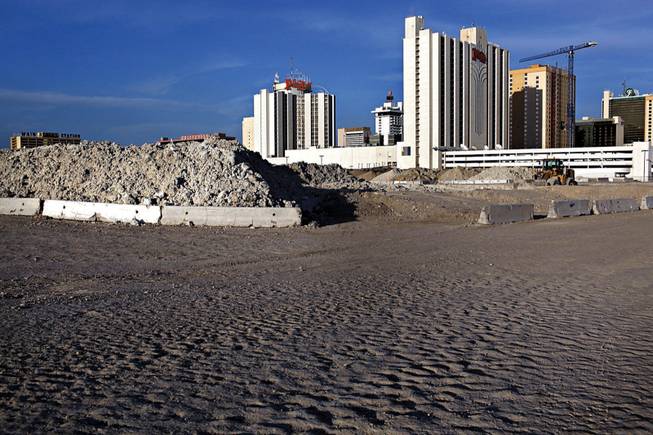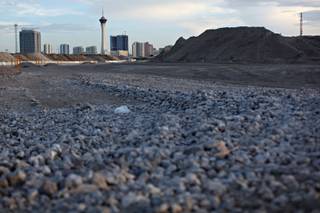
Contaminated soil is piled up Sunday at Symphony Park, where the Smith Center and other development is planned.
Tuesday, July 21, 2009 | 2 a.m.
Related Document (.pdf)
Sun Archives
- Union Park's new name music to city officials' ears (5-20-2009)
- Smith Center contractor upsets labor (5-9-2009)
- City Council approves performing arts center funding (5-6-2009)
- City sells $85 million in bonds to finance downtown projects (3-18-2009)
- Council OKs up to $100 million in redevelopment bonds (3-4-2009)
Beyond the Sun
Symphony Park
Las Vegas officials have long known that before they create a sparkling new downtown at Symphony Park they must deal with remnants of the site’s past as a rail yard.
The 61-acre site is a brownfield, an abandoned industrial site that had been home to Union Pacific Railroad Co.’s local refueling station — and is still home to dirt contaminated by diesel fuel and other petroleum hydrocarbons.
As the park’s second major project takes root, the city and the railroad — each claiming the other is ultimately responsible for up to $30 million in costs for soil cleanup called “remediation” — have reached a truce.
The city and Union Pacific have each agreed to foot $5 million of the first $10 million in cleanup efforts so that construction of the Smith Center for the Performing Arts can go forward.
But that out-of-court contract between the parties has merely placed the larger legal fight on hold.
Late last month the city sued Union Pacific over the cleanup cost.
The city’s suit, which was moved to U.S. District Court, claims Union Pacific had agreed to continue to be responsible for the bulk of the site’s cleanup despite the land being sold first to private developers in 1996 and then to the city four years later.
According to Scott Adams, the city’s chief urban redevelopment officer, the $10 million contract mentioned by Mayor Oscar Goodman during a recent City Council meeting was necessary so that the Smith Center project wouldn’t be delayed.
At the meeting, Goodman called Union Pacific’s chairman “a gentleman” for agreeing to a temporary solution despite their pending court battle.
“They believe they’re right; we believe we’re right,” Adams said. “We just got to a point where we needed some clarity. We needed to get through the Smith Center.”
In fact, the Smith Center site, near the center of the park, might prove to be the costliest remediation, Adams said, because tests have shown the soil there is among the dirtiest at the site.
Union Pacific has yet to file its response to the June 30 suit, according to court files. But a spokesman said the Omaha, Neb.-based company is interested in an amicable resolution.
“Union Pacific has been negotiating with the parties for an extended period of time to try to resolve this long-standing disagreement about how remediation costs should be allocated,” Union Pacific spokesman Tom Lange said in a written statement.
“We are disappointed that those efforts have been unsuccessful. We cannot comment on the details of the recent lawsuit that was filed, but we can say we remain interested in coming to an agreement with the parties involved,” Lange wrote.
So far, remediation costs have totaled more than $9 million out of the expected $30 million total for cleanup of the land. That includes about $575,000 for the soil underneath the Cleveland Clinic Lou Ruvo Center for Brain Health; $2 million for the project’s Phase 1 infrastructure costs; and $6.5 million for the Phase 2 costs, including remediating the Smith Center soil, which is the bulk of that amount, Adams said.
Officials of the Smith Center and its main contractor, Whiting-Turner Contracting Co., declined to comment.
Las Vegas has tried to shield private developers at Symphony Park from the bulk of the cleanup costs, said Adams and Rita Brandin, senior vice president and development director for Newland Communities, which is developing Symphony Park on behalf of the city.
In the city’s agreements with developers such as the World Jewelry Center and the Charlie Palmer Group, which is planning a boutique hotel on Symphony Park, the developers will do the soil and environmental testing necessary to determine the remediation costs.
The city then has agreed to pick up $12 per square foot of the cleanup costs — which has so far been enough to pay for all of those expenses, Brandin said. (The city hopes to recover those expenditures from Union Pacific.)
Once the construction cranes come in, here’s how it works:
After the soil is dug up, it’s moved to a stockpile area, Brandin said, where it is being looked after by the city’s certified environmental manager, in this case, a San Diego-based company called Kleinfelder. The company tests the soil again to gauge whether it’s “clean” of contaminants — meaning whether they’re below a certain level of parts per million.
If it is not clean, the soil is removed by Las Vegas Paving Corp. and burned to remove the contaminants. Then, either the burned soil or new soil is brought in to the replace the original soil.
According to a 2007 Kleinfelder study, diesel-oil-contaminated dirt resides under most of Symphony Park’s surface.
Kleinfelder’s certified environmental manager for Symphony Park, Daniel Burns, said that the soil tested at the three sites dug up so far — Ruvo, the first phase infrastructure and the Smith Center — contained only diesel fuel and oil in concentrations above so-called clean levels. The petroleum hydrocarbons were discovered to be at the “contaminated, nonhazardous” level of soil pollution, Burns said, and therefore had to be cleaned.
Through the late 1980s, Union Pacific used the Symphony Park site as a refueling, cleaning and maintenance station for its trains. The company had used the site as a rail yard for more than 80 years.
The soil and ground water beneath Symphony Park have already been cleaned up once. State environmental regulators in 1992 forced Union Pacific to remove toxins such as lead and arsenic to make way for the Clark County Government Center, south of Symphony Park.
But according to a spokeswoman with the Nevada Environmental Protection Division, more cleanup is necessary, in large part because homes, and not just businesses, are to be developed on the park’s site.
“When our work plan was closed, the agreement was that Union Pacific would work with the purchaser to finish cleaning up the land,” division spokeswoman Jill Lufrano said. “An agreement needs to be worked out between the parties.”
Lufrano said her agency will continue to monitor the site’s cleanup efforts.


Join the Discussion:
Check this out for a full explanation of our conversion to the LiveFyre commenting system and instructions on how to sign up for an account.
Full comments policy